Dad and I headed to our deer hunting property, a large tract of hardwoods, comprised of broken, rolling hills, just thick enough to keep the shooting close. It was cold, as mid-December in Upstate New York can definitely be, but there was no wind and the sun was shining. Our regular rifle season had closed, and as we both had tags left over, we took advantage of the late muzzleloader season. Dad had his old faithful: A Lyman Great Plains percussion rifle in .54 caliber — and I had a Hawken knockoff that, well, sort of shot around corners. While Dad’s rifle was, and still is, a good shooting gun, I wished at the time I had a better gun. In the still morning, I heard the unmistakable ka-thwap of Dad’s Lyman, and shortly thereafter I was assigned the task of dragging his six-pointer to the truck. That was 25 years ago.
My, but how the muzzleloading rifle has come an awful long way in my hunting career. Yes, I have an affinity for a finely stocked, traditional muzzleloader — a flintlock with a long barrel and fine furniture grabs my eye immediately — but those guns can be as expensive, if not more expensive, than a quality bolt-action centerfire. If you’re looking for a muzzleloader that is nothing more and nothing less than a rifle to extend your season, then there are more options available now than there ever has been.
The Thompson/Center Impact is one of those rifles.
SPECS
- Type: Muzzleloader
- Cartridge: .50
- Capacity: 1 rd.
- OAL Length: 41.5 in.
- Barrel Length 26 in.
- Length of Pull: 12.5 in. – 13.5 in. adjustable
- Weight: 6 lbs., 8 oz.
- Trigger: 3 lbs., 1 oz. (tested)
- Stock: Polymer
- Finish: Blue/black composite
- Sights: Green fiber optic (front); adjustable red fiber optic (rear)
- MSRP: $263
- Manufacturer: Thompson/Center
Construction and Conformation
Let’s get this out of the way right now. The Thompson/Center (T/C) Impact isn’t one of those guns which you’d proudly extract from the gun safe, just to brag to your hunting buddies while sharing a beer over the holidays. It is, however, a solid gun for the money. It is a gun that fills a need: it will, invariably deliver a bullet where it needs to go and help to extend your hunting time. It has all the features you need and none that you don’t.
The Impact is a break action, .50 caliber in-line muzzleloader fueled by a 209 shotgun primer. It is housed in a basic black polymer stock, which is actually adjustable for length of pull, making it a rather versatile design. The action is broken by a retractable hood with two built in ears that are reminiscent of an AR-15 charging handle, making the operation truly ambidextrous. The breech plug screws in and out with just five turns. A quality wrench is provided, quickening cleaning time and preventing the annoying plug seizure that can plague any inline muzzleloader. My test rifle was the blued/black stock model, there are camo stock options as well as the Weather Shield metal coating, and had a 26-inch barrel length common to all the models.
Though it is drilled and tapped for scope mounting, the Impact comes equipped with fiber optic sights: two red dots on the rear sight and one green dot on the front sight. They allow for clear and crisp target acquisition. Taking into account that this rifle is setup for the possibility of optics, I’d prefer a bit more distance between the front and rear sights for a longer sighting radius; that aside the sights align well.
The Impact features an external hammer that is small enough to be unobtrusive, yet big enough to get a solid grip, even with gloves, to drive the operation. The trigger is crisp, if perhaps a little on heavy, and moves significantly rearward when the hammer is cocked.
A steel ramrod is housed on the underside of the barrel, nestled comfortably in the polymer forend and one barrel retainer; the ramrod wouldn’t make the telltale rattle that will instantly spook game.
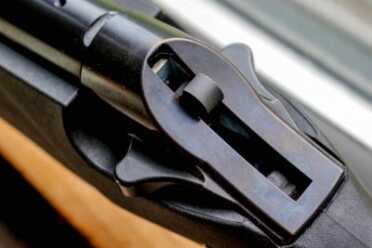
The external hammer is large enough to allow a solid purchase but small enough to remain unobtrusive.
The stock is an ergonomic design; it appears that T/C spent a bit of time in development. It carries very well in the hands, even though the stock features sling studs. Both pistol grip and forend give a positive feel when shouldering the rifle. The 1-inch spacer, which allows the user to modify the length of pull (LOP), makes a considerable difference for shooters of smaller stature or for those wearing heavy hunting clothes, as I do in the late seasons. My own normal length of pull is right around 14 inches or 14 ¼ inches, so I left the spacer in for testing, at a length of pull of 13 ½ inches. Were I to buy this rifle for my wife, I’d yank that spacer out in a heartbeat, reducing the LOP to 12 ½ inches. The Monte Carlo stock gave proper alignment with the iron sights; should you opt for a scope it may feel a bit low. This compromise has been an issue for time immemorial and will continue to be so.
T/C also offers the rifle as a package deal called: Premium Pack, which includes an extended cleaning jag, some Natural Lube 1000 Plus Butter Bore, cleaning patches and more. I was also sent some Shock Wave muzzleloader bullets which are a sleek 250-grain flat base spitzer design, made for use with the Mag Express plastic sabot. That Mag Express is part of the magic in the design, quickly separating from the bullet to allow it to retain as much velocity as possible. The Shockwave is a bonded core bullet with a yellow polymer tip, engineered to stay together if the shot is close and impact velocities are high, yet give reliable expansion at farther distances when things slow down a bit.
At the Range
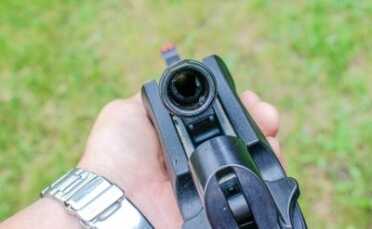
A clean muzzeloader is imperative for accurate shooting. Crud, filth and residue will build up after a few shots.
The Impact is a heavy-duty rifle, fully capable of using 150-grains of Pyrodex, or three of the 50-grain pellets. So, I gathered up a box of Pyrodex pellets, The Shockwave saboted bullets, and some good ol’ CCI 209 primers, and headed to the range. As this rifle was to be tested with iron sights, I decided that 65 yards was a good representative hunting distance to test the accuracy. To get things rolling, I cleaned the rifle thoroughly to remove the rust preventative it was shipped with and took a few shots using one Pyrodex pellet. As you can imagine, recoil was minimal, but more importantly I wanted to verify that things were operating properly; all was right with this gun. I could feel, while seating the bullets, that things tended to get quite dirty after three shots, so I kept the ramrod loaded with the cleaning brush, and used the Rugged Range Rod for loading purposes. Accuracy was acceptable, with three shots staying within a 3-inch group. Remember, this is an iron-sighted gun with a rather short sighting radius.
Two Pyrodex pellets gave an appreciable difference in report and recoil — though neither posed an issue off the bench — and a slight increase in accuracy. I was able to keep three shots in 2½ inches, but the point of impact changed a bit. I adjusted the rear sight to bring the point of impact down and to the right, and within a few shots I was back to hitting where I wanted. With two shots, things gummed up noticeably more, as when the breech plug was pulled, a considerable amount of residue was visible just ahead of the plug. Scrub, run a patch, scrub some more, run more patches, rinse and repeat. With two pellets (100-grains of powder) I felt this gun was right where it should be, at least as an iron sighted gun. The Birchwood Casey deer targets I was using are considerably smaller than a life-sized animal and still allowed me to pick the spot on the animal’s shoulder, focusing clearly on that green fiber optic front sight and the target simultaneously.
Three Pyrodex pellets, the max load for this rifle, truly ramped up the recoil, making the rifle jump off the bench and attaining a recoil speed that bordered on uncomfortable. Accuracy wasn’t as good as the two-pellet load, with groups opening up to 4 inches. I noticed an increased effort in removing the breech plug; this was more than likely due to the increased thrust on the receiver. The T17 Breech Plug grease helped out considerably, as did the T17 Black Powder Core Cleaner. The latter substance — a light blue liquid — broke up much of that burnt residue around the lip of the breech plug, allowing the black nylon scrub brush to get that nasty stuff out of the breech and let that plug screw back in effortlessly.
Were this the rifle I were taking deer hunting, I’d definitely use the two pellet load and try to keep shots this side of 100 yards. At those distances, I’d feel confident keeping my shots in the vital zone.
The only niggle I had during the range testing: when the rifle is fired, the steel ramrod seemed to jump out of the retainer, moving forward 2 or 3 inches. While it wasn’t an issue at the range, it might pose an issue in the woods, where the excitement of a hunt may result in the rifle’s muzzle lowering rapidly after shooting at a nice buck, and the ramrod could potentially fall out. I’d wrap a small piece of mesh tape around the rod to secure it while hunting.
Observations and Opinions
Though the muzzleloading rifle market has quite a bit to offer, if this style of rifle isn’t your primary hunting tool a large investment may not make a lot of sense. With an MSRP of $263, it’s pretty clear to see that you can’t really get hurt owning this rifle. For the hunter looking to extend their season, especially the later deer seasons, I personally feel the T/C Impact represents a good balance of useable features and affordability. With the adjustable stock length, it would make a great rifle for a young hunter; it’s a muzzleloader that will grow with the hunter. I really appreciated the design of the breech plug. It was easy to remove for cleaning, yet plenty strong enough to handle the hottest loads recommended for the gun. The T17 breech plug grease kept things soft in the breech; I’m sure you’re all familiar with the struggles of removing a stuck breech plug. I’ve seen it render some rifles useless.
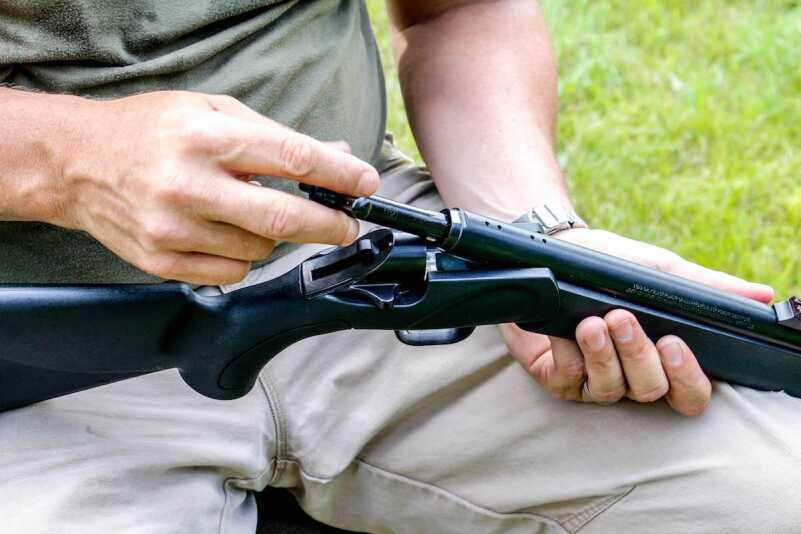
Using the T-handle wrench to remove the breach plug proved easy. The assistance of T17 Breach Plug grease after firing the max load: three Pyrodex bullets.
For range work, I really enjoyed the T/C Rugged Range Rod; the palm saver knob makes loading the rifle repetitively a breeze without the blisters of yesteryear. The Impact’s trigger was more than adequate, it moves rearward when the hammer is cocked, and breaks cleanly at 3 pounds, 1 ounce, according to my Lyman digital trigger scale. I like the rearward move, as it allows the shooter to know whether the gun is cocked properly by the position of the trigger. Those fiber optic sights worked very well on light and dark targets. The Williams rear sight is adjustable for both windage and elevation.
Though the word Tupperware is thrown around the industry frequently when describing a polymer stock, I didn’t hate the feel of the Impact’s stock. Again, we’re not exactly talking about hand-laid fiberglass here, but the design affords a good grip, especially in a quick-shouldering situation. The forend is only slightly rounded, with grooves along the sides for the fingers of the off hand to hold firmly. The pistol grip is compact enough for smaller hands, yet still comfortable for larger hands. I might appreciate a more open grip, but I may also be picking nits.
The Impact’s barrel uses a 1:28-inch twist rate, and is light enough to carry well yet heavy enough to reduce felt recoil. The overall feel of the Impact — more than likely due to the polymer stock, is that it is a touch nose-heavy, but not to the point that it poses an issue, though it might with the stock spacer removed.
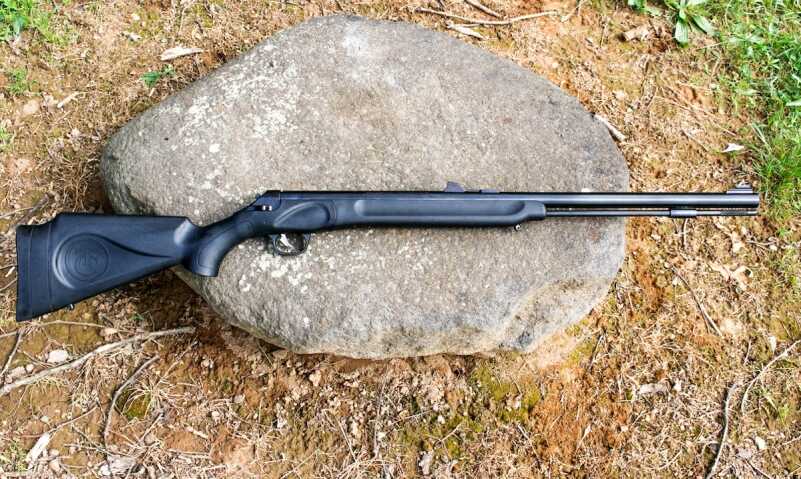
The author found the T/C Impact to be a great muzzleloader for the price. It could prove ideal for those who want to get into muzzle loading and don’t want to spend a ton of money.
Overall, the Thompson/Center Impact is well worth the investment and makes an affordable addition to the gun safe. If you want to spend more time afield, and you can take advantage of the special muzzleloading seasons, the T/C Impact is a worthy means of doing so.
For more information, visit https://www.tcarms.com/firearms/muzzleloaders/impact#information.
To purchase a muzzleloader on GunsAmerica.com, click this link: https://www.gunsamerica.com/Search.aspx?Keyword=Muzzleloader.

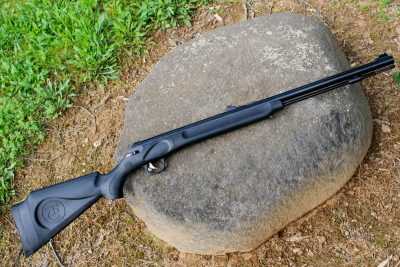
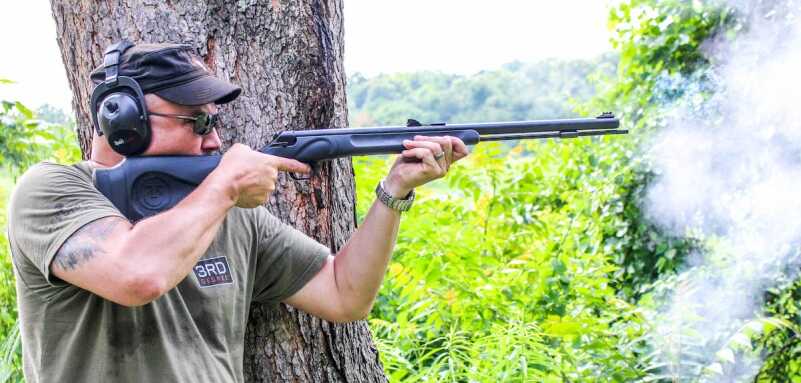
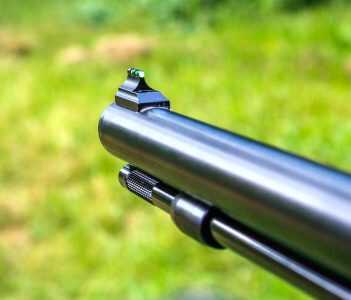
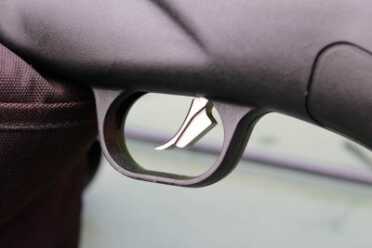
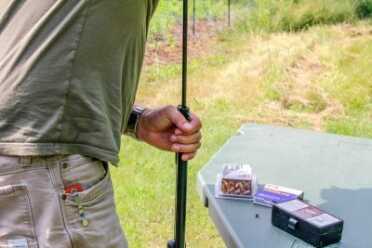

I give it a 7 out of 10 stars ☆☆☆☆☆☆☆
“I’m sure you’re all familiar with the struggles of removing a stuck breech plug. I’ve seen it render some rifles useless.”
Not a problem if you have a can of Kroll’s oil on your workbench. That stuff works magic on stuck, corroded parts.
In regards to the ramrod moving forward, you may try a smaller hair tie that ladies use for their pony tails. I had the same problem and this solved it. I was in my tree stand about 10 years ago and had not seated the bullet properly. After shooting a nice buck, the ram rod fell to the ground. The buck stood below me and need another round, try the hair tie it works.
You get what you pay for with this muzzleloader. It works on a budget but you better make the first shot count and you better hope you don’t have to reload it in the field without cleaning it and yes I use the yellow easy glide Shockwaves too. You hard core loose powderers may as well come to realize that 90% of todays hunters are going to use pellets no matter how much you harp on the advantages of “your” Blackhorn 209!
It’s been done before. H&R made the Huntsman model some years ago, and it’s a very similar weapon. Apparently based on one of their single shot shotguns, it was available in .45, .50, .58, and 12 gauge. It was a nice, handy, short barreled gun that has the reassuringly familiar look and feel that their shotguns and single shot rifles have. These can be picked up for a low price online, and are worth considering.
Although the rifling twist rate is too fast to work well with patched round balls, I am interested in a test using round balls. Very informative article. There are still many shooters who prefer a round ball and potentially disappointed if they do not know about twist rates. The twist rate should be listed among the list of specifics in my opinion.
I’m with Sam, Blackhorn 209 is the only way to go these days in 209 primer guns. I have an Impact that now belongs to the wife. 90grs of B209, a black Harvester crushed rib sabot, with any 250gr bullet you prefer, produces 1″ groups at the range all day long.
It amazes me to read yet another muzzleloading review where the author uses the black powder substitutes of yesteryear with their poor velocity and barrel/breech plug fouling.
Shooting Pyrodex makes no sense with Blackhorn 209 readily available. 209 is non-corrosive, has much higher velocity (and velocity is much more consistent shot to shot), clean burning (shoot all day without cleaning), and is easily measured by weight or volume. I own and shoot an Impact and would never wastr my time with Pyrodex, the Model T of Black powder substitutes.